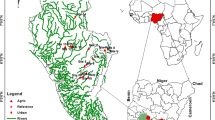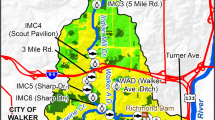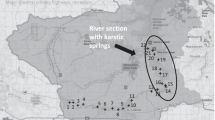Abstract
This project was designed to establish baseline aquatic biological community structure and physical habitat conditions in select wadeable streams within the California Central Valley. A secondary objective was to evaluate possible water quality differences between site types and seasons. Two agricultural and two urban streams were monitored in spring and fall for two consecutive years beginning in the fall of 2002. Bioassessment sampling was conducted according to modified US EPA methods. The study included physical habitat assessment, water and sediment chemical analysis and characterization of the benthic macroinvertebrate community at each site. Water samples were analyzed for selected organophosphate insecticides, pyrethroid insecticides and herbicides, while sediment samples were analyzed for pyrethroids only. All sites had substantial physical habitat and water quality impairments, and the absence of pollution intolerant macroinvertebrates and dominance of pollution tolerant macroinvertebrates were indications of biological impairment. Due to the limited amount of water quality and pesticide data collected, it was not possible to definitively demonstrate any cause and effect relationships between BMI community structure and water quality or pesticide concentrations. Though most physical habitat parameters were similar and EPA physical habitat scores revealed on no significant differences between urban and agricultural sites (P = 0.290), a significant difference was seen in substrate embeddedness (P = 0.020). Dominant taxon found at all sites were chironomids, amphipods, and oligochaetes. Benthic macroinvertebrate metrics were significantly different between both types of sites (P = 0.001) and seasons (P = 0.014). Chironomidae taxon and those of the functional feeding group scrapers were greater at urban sites, while those of the functional feeding group filterers were greater at agricultural sites. In addition, the metric groups Chironomidae, filterers, and predators were found in greater numbers in the spring than the fall.
Similar content being viewed by others
References
Bacey, J. (2003). Instructions for sampling BMIs in wadeable waters using the multi-habitat method (Non-point source) [Online], California Department of Pesticide Regulation, SOP No. FSWA010.00. Retrieved February 23, 2004 from http://www.cdpr.ca.gov/docs/empm/pubs/sops/fswa010.pdf.
Bacey, J., & Moncada, A. (2004). Instructions for sampling benthic macroinvertebrates in wadeable waters using the modified US EPA EMAP method. California Department of Pesticide Regulation, SOP No. FSWA015.00. Retrieved March 9, 2005 from http://www.cdpr.ca.gov/docs/empm/pubs/sops/fswa015.pdf.
Brown, L., & May, J. (2004). Periphyton and macroinvertebrate communities at five sites in the San Joaquin River basin, California, during June and September 2001. US Geological Survey, Report No. 2004-5098.
California Department of Fish and Game (1999). Test 132:96-hour acute Ceriodaphnia dubia test for Chlorpyrifos. Elk Grove, California: Aquatic Toxicology Laboratory.
Chambers, D., & Messinger, T. (2001). Benthic invertebrate communities and their responses to selected environmental factors in the Kanawha River basin. West Virginia, Virginia, and North Carolina, US Geological Survey, NAWQA, Report No. 01-4021.
Graca, M. A. S., Ferreira R. C. F., & Coimbra, C. N. (2001). Litter processing along a stream gradient: The role of invertebrates and decomposers. Journal of the North American Benthological Society, 20(3), 408–420.
Harrington, J., & Born, M. (1999). Measuring the health of California streams and rivers. Sustainable Land Stewardship Int’l. Inst.
Johnson, D. E. (1998). Applied multivariate statistics for data analysts (pp. 567). Pacific Grove, California: Brooks/Cole.
Merritt, R. W., & Cummins K. W. (1996). An introduction to the aquatic insects of North America (3rd edn.) (p. 635). Dubuque, Iowa: Kendall/Hunt.
Peckarsky, B. L., Fraissinet P. R., Penton M. A., & Conklin D. J., Jr. (1990). Freshwater macroinvertebrates of northeastern North America (pp. 42, 273). Ithaca, New York: Cornell Univ. Press.
Pennak, R. W. (1989). Fresh-water invertebrates of the United States: Protozoa to Mollusca (3rd edn.) (p. 209). New York, USA: Wiley.
Resh, V. H., & Rosenberg, D. M. (1984). The ecology of aquatic insects (pp. 363, 377, 520). New York: Praeger.
Segawa, R. (1995). Chemistry laboratory quality control, California Department of Pesticide Regulation, SOP No. QAQ C001.00, Available at http://www.cdpr.ca.gov/docs/empm/pubs/sops/qaqc001.pdf.
State Water Resources Control Board (2003). A compilation of water quality goals. Retrieved January 21, 2005 from http://www.swrcb.ca.gov/rwqcb5/available_documents/wq_goals/index.html#anchor274991.
Tetra Tech, Inc. (2003). The Status and Future of biological assessment for California streams. Technical Report. Prepared for the California State Water Resources Control Board, Div. of Water Quality.
Townsend, J. (2002). Practical statistics for environmental and biological scientists (pp. 87–90). West Sussex, England: Wiley.
US EPA (1986). Ambient water quality criteria for dissolved oxygen. Technical Report, No. 440/5-86-003. Retrieved from http://www.epa.gov/cgi-bin/claritgw.
US EPA (1999). Rapid bioassessment protocols for use in streams and wadeable rivers: Periphyton, benthic macroinvertebrates, and fish. Office of Wetlands, Oceans, and Watersheds. Technical Report, No. 841-B-99-002.
US EPA (2001). Environmental Monitoring and Assessment Program-Surface Waters: Western pilot study field operations manual for wadeable streams. Regional Ecology Branch, Western Ecology Div.
US EPA (2005a). Conductivity. Monitoring and assessing water quality. Office of Water, Technical Report, No. EPA 841-B-97-003. Retrieved December 23, 2005 from http://www.epa.gov/volunteer/stream/vms59.html.
US EPA (2005b). ECOTOX Database. US Environmental Protection Agency. Retrieved January 11, 2006 from http://www.epa.gov/ecotox/.
Author information
Authors and Affiliations
Corresponding author
Rights and permissions
About this article
Cite this article
Bacey, J., Spurlock, F. Biological Assessment of Urban and Agricultural Streams in the California Central Valley. Environ Monit Assess 130, 483–493 (2007). https://doi.org/10.1007/s10661-006-9438-8
Received:
Accepted:
Published:
Issue Date:
DOI: https://doi.org/10.1007/s10661-006-9438-8




